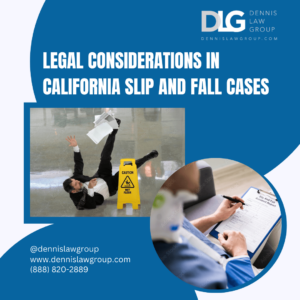Slip and fall accidents in California can result in serious injuries, and when they occur due to the negligence of a property owner or possessor, legal considerations come into play. This article explores these, along with your legal rights and responsibilities associated with slip and fall accidents.
I. Premises Liability and Duty of Care
In California, property owners and possessors have a legal duty of care to maintain their premises safe for visitors. Understanding the concept of premises liability is essential in slip and fall cases. Key points include:
1. Defining Premises Liability
- Explanation of premises liability and its application to slip and fall accidents.
- The duty of care owed by property owners and possessors to visitors.
2. Negligence and Slip and Fall Accidents
- Discussing how negligence plays a crucial role in slip and fall cases.
- Exploring the elements of negligence, including breach of duty, causation, and damages.
II. Establishing Liability in Slip and Fall Cases
Proving liability is essential in California slip and fall accidents. This section covers the various aspects of establishing liability, including:
1. Burden of Proof
- Discussing the burden of proof on you, the plaintiff, to demonstrate that the property owner breached their duty of care.
- The importance of gathering evidence, such as photographs, witness statements, and incident reports.
2. Comparative Negligence
- Exploring the concept of comparative negligence and its impact on slip and fall cases.
- Understanding how the plaintiff’s own negligence may affect their ability to recover damages.
III. Potential Defenses in Slip and Fall Cases
When faced with a California slip-and-fall lawsuit, property owners or possessors may employ various defenses to challenge your claims. It is important to be aware of these potential defenses, which may include:
1. Lack of Notice
- Arguing that the property owner or possessor had no prior knowledge of the hazardous condition that caused the slip and fall accident.
- Demonstrating that the dangerous condition occurred suddenly and without any opportunity for the property owner to address it.
2. Open and Obvious Hazards
- Asserting that the dangerous condition was obvious, a reasonable person should have noticed and avoided it.
- Emphasizing that the plaintiff’s failure to exercise caution contributed to their own injurie
3. Assumption of Risk
- Arguing that the plaintiff voluntarily assumed the risk of injury by engaging in activities or entering areas where the potential danger was known or should have been known.
- Demonstrating that the plaintiff was aware of the risks associated with the premises but chose to proceed anyway.
IV. Seeking Compensation and Legal Recourse
In California slip and fall cases, injured individuals may be entitled to seek compensation for their damages.
1. Insurance Claims
- You may want to file an insurance claim with the property owner’s liability insurance company. Discuss with an experienced attorney first.
- Document the incident, injuries, and medical treatment to support your claim.
2. Consult with an Attorney
- Explore how the right accident attorney can provide guidance, evaluate your case, negotiate with insurance companies, and/or represent you in a lawsuit.
3. Statute of Limitations
- The statute of limitations (or SOL) establishes the timeframe within which a lawsuit must be filed.
- Every state is different, so be sure to speak with your attorney to find out the SOL in California.
Slip and fall accidents can lead to severe injuries and significant financial and emotional burdens.
For more information on handling your legal claim or speaking with an experienced attorney, contact the Dennis Law Group today at (888) 820-2889 for a free consultation and visit www.dennislawgroup.com.
